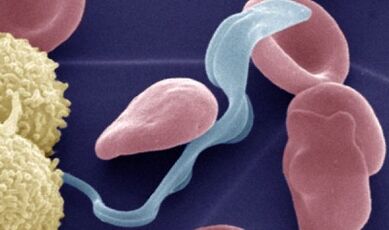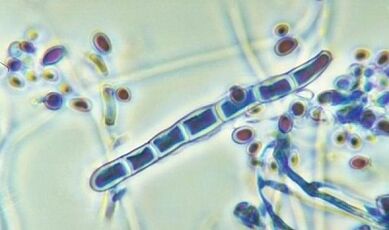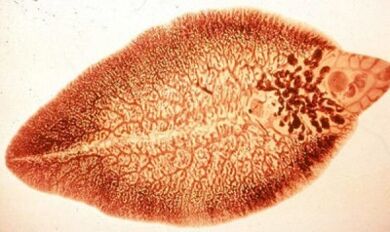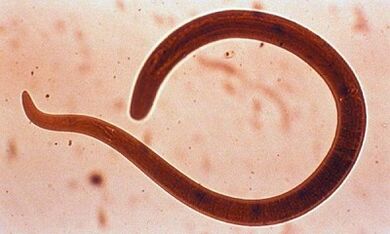Human parasites can inhabit all organ systems. The vital activity of helminths can be a prerequisite for the development of cancer, and micro fungi and mites cause allergies.
The human body can be inhabited by at least 300 species of parasites, including representatives of bacteria, viruses, protozoa, microscopic fungi, helminths (parasitic worms), individual arthropods. These organisms not only consume nutrients assimilated by the host, but also poison them with their essential activity products. In accordance with modern medical rules, the concept of "parasites" does not apply to prenuclear (prokaryotic) organisms: bacteria and viruses. It features protozoa, fungi, worms, arthropods that live in the host body, found exclusively in them.
Microparasites

Human and animal organisms are fertile environments for the life of microscopic fungi, as well as protozoa. Invisible to the naked eye, it causes damage to the skin and internal organs.
Protozoa parasite
Infections caused by protozoa are called protozoa. Such diseases are prevalent in the tropics as well as in the middle latitudes. About 50 species of parasitic protozoa on human organs and tissues. They can be infected through sexual contact, food or insect bites.
Giardiasis is very widespread. Up to 40% of children and 10% of adults have this pathology. Lamblia's favorite habitat is the small intestine. The disease can be accompanied by digestive disorders, allergic reactions, although often asymptomatic. Pathogens are spread through food channels - with uncooked water and contaminated food.
According to various sources, from 30 to 50% of the world's population is infected with toxoplasmosis. The pathogen often lives in the host organism without any clinical manifestations. Toxoplasma poses the greatest danger to pregnant women: it causes intrauterine fetal death or severe malformations. Infection occurs through contact with domestic mammals (cats, rabbits, rats) and the consumption of uncooked meat.
The most common sexually transmitted infection is protozoa. This is trichomoniasis. More than 150 million people are infected worldwide each year. The manifestation of the disease is determined by which organ is affected. In women, Trichomonas lives in the vagina, causing inflammation, accompanied by urethritis. In men, protozoa affect the prostate gland, the seminal vesicles, in severe cases causing prostatitis, although more often the infection is not symptomatic.
In the tropics, diseases such as malaria, leishmaniasis, Chagas disease, and sleep disorders are well known. The causative agents are plasmodia, leishmania and trypanosomes respectively. Parasites are carried by blood-sucking insects: mosquitoes, tsetse flies, triatomic insects. By biting sick animals or people, they acquire and spread the causative agent of the disease.
Parasitic fungus

About 100 species of fungi are known to be quite dangerous to humans. Their optimal habitat is a warm, humid body area, for example, the interdigital space. However, these organisms can also infect the skin and other areas of the human body.
Fungi of the species Trichophyton, Microsporum, Epidermophyton cause dermatomycosis: ringworm and pityriasis versicolor, sores on the feet, scalp, rarely mucous membranes. The causative agent of this disease can be transmitted to humans from animals or sick people. In severe cases, bacterial infections combine with dermatomycosis.
Fungi and their spores are no less dangerous to humans. They cause the following diseases:
- penicillin;
- mucosis;
- aspergillosis.
This pathology is characterized by inflammation of all parts of the airways without exception, otitis media, and various allergic reactions. In severe cases, parasitic fungi cause pneumonia and even bronchial asthma. People with weakened immunity and chronic diseases are most susceptible to fungal infections.
Helminths
The favorite habitat of parasitic worms is the digestive tract of humans and animals, where they eat the food, bile, and blood of the host. All helminths belong to the following classes:
- worm ring (nematode);
- flatworms (tapeworms and worms).
Flat parasitic worms
Eggs and larvae of trematodes (flat worm flux) most often enter the human body with raw water, unwashed greens, meat and fish that are not hot enough. Here's how:
- hepatic;
- Chinese
- giant;
- scalpel-shaped flux;
- cats happen to be.

Sometimes a person is infected through direct contact: the parasitic parasitic parasite of the cystosome penetrates the skin of people who swim in freshwater, then enter the bloodstream, where they live and eat erythrocytes.
A large number of trematodes affect the liver, gallbladder, and ducts of these organs, causing disease - trematodes. The living environment of lung flux is muscle, subcutaneous fat tissue, brain, but most importantly, lung. This disease caused by helminth is called paragonimiasis. Metagonium is a small trematode living in the small intestine, leading to metagonimosis.
Flukes are small in size - their bodies are flat and leaf-shaped not more than 10 cm - however, the consequences of living in animal and human bodies can be fatal. The long-term parasitism of these helminths can lead to the development of cancer, cirrhosis, and gallstone disease.
Unlike trematodes, cestode bodies can reach tens of meters in length. The main route of infection with cestode is food. These worms enter the human body with uncooked meat and fish. The main environment for cestode development is the small intestine, where adult worms live, while larval forms live in the parenchyma organs (liver, lungs, spleen).
Of all tapeworms, the following are the most common:
- tapeworm increases;
- echinococcus;
- wide band;
- pig tapeworm;
- alveococcus.
Round parasitic worms
The disease caused by parasitic ringworm - nematodes - ranks first among all helminthiases in terms of frequency of development. The habitat of most adult parasites is the intestine, but at some stage of their life they can move to the muscles, lungs, heart, and pharynx. In the human population, the following nematodes are common:

- pinworms;
- worm ring;
- toksokar;
- Trichinella;
- mine worms;
- Strongylids.
Eggs and larvae of ringworm enter the human body through food and water. Nematodes like mine worms and quilts themselves attack the host's body. This worm is found mainly in the tropics.
Nematodes everywhere are pinworms, ringworms and toxocaras. The first most often attacks children, causing enterobiasis - the most common helminthiasis. Dogs are carriers of Toxocara, although these nematodes can also infect humans. Worms live in humans and are harmless to most animals, except pigs.
Parasit arthropod
Cestodes, trematodes and parasitic nematodes are adapted to live in the host internal organs. In contrast, most parasitic arthropods live on the surface of the body. Often, a person is infected with lice and mites, the causative agent of demodicosis and scabies. This parasite is dangerous because it can carry pathogenic bacteria and rickettsia that cause Volyn fever, typhoid and relapse.
Lice drink human blood and parasitic mites live on human skin. Scabies itching through the ducts in it, demodex live in the hair follicles and sebaceous gland ducts. The important activity of this parasite leads to allergies, accompanied by rashes, redness on the skin and itching.
The world in which we live is growing rapidly, living standards are rising, and today it seems a lot that parasitic diseases are prevalent in third world countries. However, population migration leads to the spread of such pathologies beyond the natural focus. Accordingly, it is important to remember the basic rules of hygiene, adherence to it will help prevent infection.
























